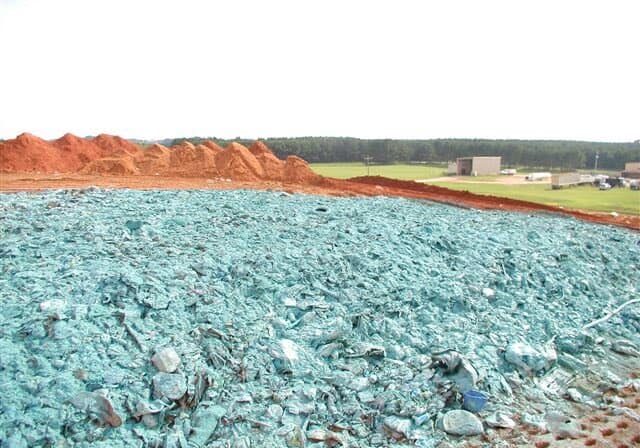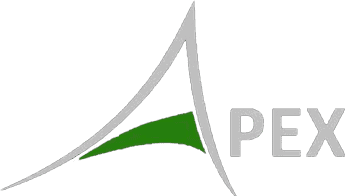Hydroseeding for Landfill Alternative Daily Cover (ADC)

Share this article!
Using an Alternative Daily Cover for landfills saves significant amounts of both money and time, while extending the working life of the landfill. Hydroseeding for landfills is one method that allows Alternative Daily Covers (ADCs) to be applied quickly and easily, which adds to its variety of benefits, like cost savings, for landfill applications.
There are different types of landfill ADCs that can be used with a hydroseeder, and done correctly, each can help prolong the life of the landfill, meet regulatory requirements, and cut down costs.
What is Landfill Alternative Daily Cover (ADC)?
Landfill Alternative Daily Cover (ADC) is a method used to safely maintain landfills and ensure the community and the landfill’s safety.
In order to operate without hazards and meet regulations for municipal landfills, landfills are typically required to cover the active face of a solid waste landfill. This means at the end of each day, when the last of the day’s trash has been dumped into the site, the surface must be covered to prevent the spread of diseases, reduce odors, creature activity such as scavenging, and blowing litter. Landfill covers also reduce the possibility of dangerous fires.
Types of Landfill Alternative Daily Cover
Landfills have often used types of dirt, and large amounts of it, as a daily cover, which is not only costly, but labor intensive. However, several types of alternative daily covers have been developed that can be used in landfills. The term ‘alternative daily cover’ refers to daily covers that are generally not earth or soil-based, and thus ‘alternative.’ Materials that are often used in ADCs include:
- Shredded tires
- Construction waste
- Auto-shredder waste
- Spray foam products
- Synthetic blankets or panels
- Spray on cement
There are some additional types of alternative daily covers that do use organic material, and these can be composed of materials like compost, green materials, or sediments.
Why Use ADC? Advantages of Landfill Alternative Daily Cover
Using ADCs can benefit landfill operations in a variety of ways, and have been widely adopted by many landfills for the following reasons:
Increase Landfill Life and Capacity
ADCs generally require much less volume to cover an area, for example where 6 inches of soil might be required to meet city guidelines, only 2 inches of ADC may be required because of its added effectiveness. This translates into a longer operational life for landfill facilities, as they can accommodate more waste and do so over a longer period of time.
Control Landfill Odor and Gasses
ADCs help landfills effectively meet odor and off-gassing requirements, preventing foul smells and dangerous gasses from generating in and around the landfill. The spray-on material traps smells beneath the surface, helping landfills operate within prescribed odor guidelines.
Prevent Fires in Landfills
Flammability is a primary concern in landfill management, and ADCs help mitigate the risk of fires by controlling the exposure of the elements to the waste. The barrier provided by an ADC prevents too much oxygen from accessing the waste, and also acts to prevent potentially dangerous interaction between layers of waste that could become flammable.
Manage Scavengers and Disease Transmission
Many pests, from rats and raccoons to owls and birds, have been known to frequent uncovered waste sites. Not only does this create an unsafe environment for the community and the landfill, it can be the source of disease transmission. ADCs help prevent creature access by creating a barrier that is difficult for scavengers and other vermin to breach.
Save Money
In addition to helping landfills meet municipal requirements, ADCs also help landfills do it more efficiently. Most ADC products are more cost-effective than soil products, and because less is generally required, the cost of daily covers is reduced.
This translates into greater cost savings each day, and can also translate into greater profitability for the long term, as ADCs extend the usable life of a landfill, so sites can earn more money for a longer period of time. ADCs are also quicker to apply than other products, so time and resources can be saved from the process each day.
How to Apply Landfill Alternative Daily Cover
ADCs are commonly sprayed over the open face of a landfill, and this can be done most efficiently with a small team of people and a hydroseeder. Depending on the size of the landfill, the open face can often be covered in a matter of hours.
Blanketing or tarping ADC products can be manually laid down over the surface of the site, and this is generally more labor and time intensive than spray-on methods. As a result, hydroseeding for landfills has become the preferred choice for many sites.
Hydroseeders are Great Machines to Efficiently Spray On Landfill ADC
Hydroseeders offer several unique advantages for operating in the demanding conditions of landfills. Depending on the type of hydroseeder, they can be used to traverse the landscape of the landfill easily with their high ground clearance and rugged design.
Many can also handle large volumes of ADC material, so the job of daily covering takes less time. Spray application can be done to apply the material quickly from the back of the hydroseeder as it moves through the landfill. Because of their design, hydroseeders can be managed by a small team of trained individuals to ensure the best ADC results for the landfill.
Takeaway
ADCs offer an efficient and effective method to operate landfills lawfully and safely, and hydroseeding to apply alternative daily cover is generally the preferred approach to maximize the benefits of ADCs for landfills.
To learn more about how hydroseeding can help improve operations and reduce costs, read more about hydroseeding applications, or contact our pros at Apex for a quote on our hydroseeders.
